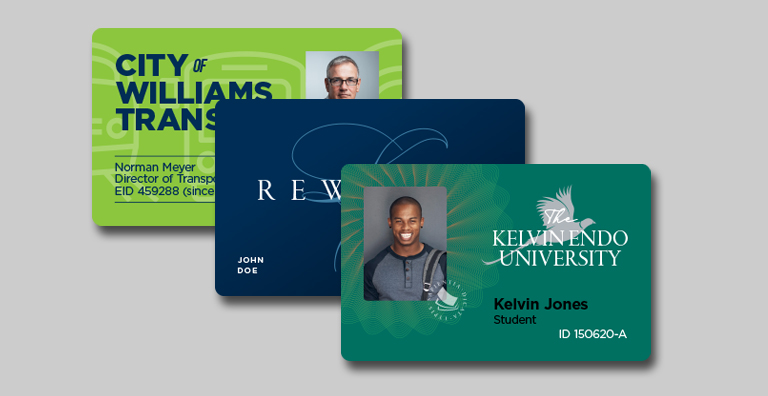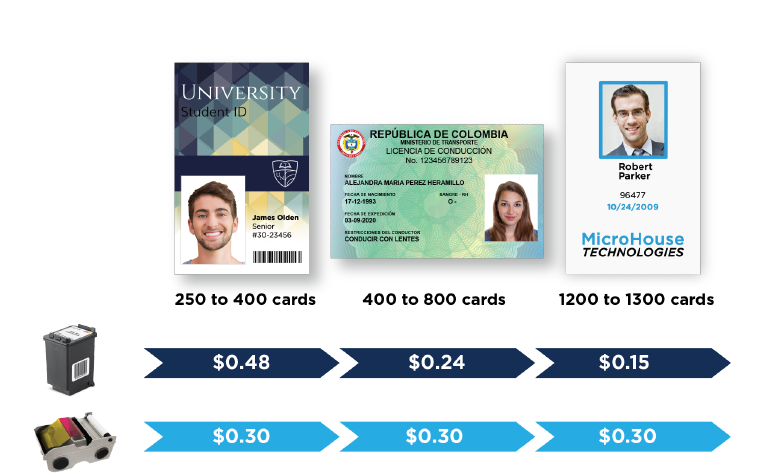Almost sounds too good to be true, doesn’t it?
Talking with both our partners and end-user customers over the years, I’ve found that a key consideration for selecting an ID card printing solution is the average cost-per-card (CPC). In other words, after the printer is purchased, consumables have been loaded and cards printed—what is the average end cost of each card printed?
Of course, many variables factor into the overall CPC. Some of the most common include:
- Initial hardware investment of the printer
- Whether or not technology cards will be used
- Number of cards printed
- Cost and yield of printer consumables such as print ribbons
For many organizations, the most frustrating of these factors is that of print ribbons because users are shackled by set ribbon roll pricing and the fixed number of images that each roll will yield. Ribbon-based printing requires that you run through an entire set of ribbon panels even if your card design does not fully utilize all panels. So, CPC based on consumables alone — whether you’re printing 10 cards or 1000 cards — remains the same. Hardly seems fair, right?
Enter Inkjet Card Printing
Because inkjet card printers use drop-on-demand (DOD) technology, the printhead only ejects ink droplets as required by the card’s design. Replacing ribbon-based printers with those that use snap-in ink cartridges not only simplifies use and maintenance but also eliminates wasting an entire set of ribbon panels for each printed card.
So, dependent on the complexity of your card design, a single ink cartridge has the potential to produce hundreds more cards than would be possible with print ribbons — bringing your card designs to life with significantly less waste and at a fraction of the cost. A recent sample card testing scenario comparing the HID® FARGO® INK1000 ID Card Printer with standard direct-to-card printing yielded the following results:
* All data presented is in Normal print mode.
Inkjet printing represents a notable paradigm shift within the card printing industry. For the first time in history, end users have much more autonomy over their end per-card cost. Something as seemingly benign as simple card design can now empower users to control their overall card issuance program cost. This is especially good news for those organizations that have previously found ribbon-based ID card printing cost prohibitive.
Other Inkjet Benefits
Inkjet printers and their specially formulated, inherently UV-stable inks also deliver higher-quality (600–1200 dpi) and more fade-resistant images, text and barcodes than ribbon-based direct-to-card printers — even without expensive overlay protectants. Better yet, solutions like the HID FARGO INK1000 utilize specially formulated inks that adhere to standard, off-the-shelf polyvinyl chloride (PVC) cards—eliminating the need for specialized card media.
Cost Savings by Design
Inkjet card printing solutions create an unmatched industry benchmark for affordability and ease of use — extending the simplicity of inkjet printing popularized for home use to retail counters and office environments. Moreover, because they utilize DOD printing technology, users have much more control over consumable usage and associated cost — simply by the card design(s) they choose.
So, can you really design your cards and IDs to lower your cost-per-card? With inkjet, the answer is a resounding “Yes, you can!”
Learn more about the HID FARGO INK1000 in this informative eBook.
Jim Meier is a Senior Director of Product Marketing with HID Global and manages the portfolio of desktop printer products. He has more than 25 years of experience working with printing technologies and has 20 patents related to these technologies.

